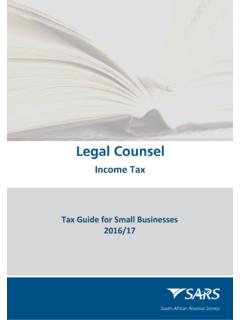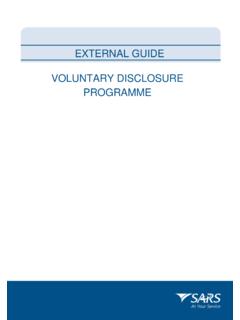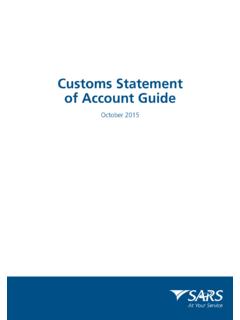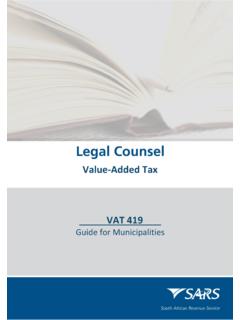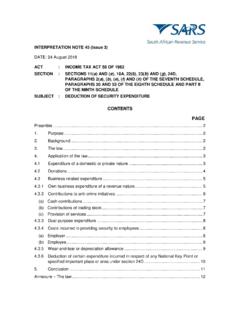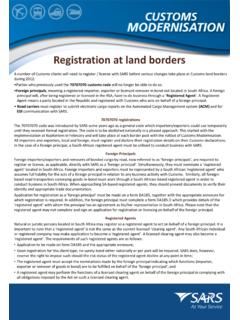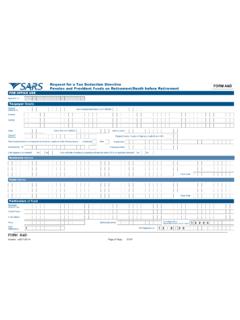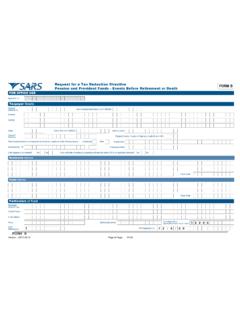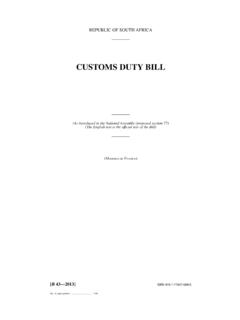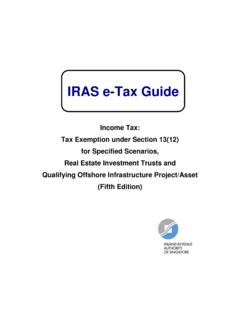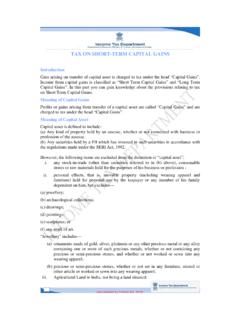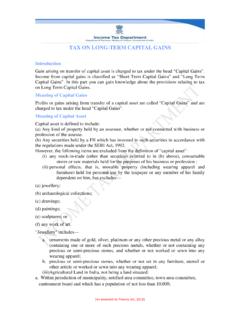Transcription of Introduction of Capital Gains Tax - SARS Home
1 ABC of Capital Gains Tax for Companies (Issue 7) 1 Income Tax ABC of Capital Gains Tax for Companies (Issue 7) ABC of Capital Gains Tax for Companies Preface This guide provides a basic Introduction to Capital Gains tax (CGT) and should not be used as a legal reference. For more information about CGT you may visit the SARS website at ; visit your nearest SARS branch; contact your own tax advisor or tax practitioner; contact the SARS National Contact Centre if calling locally, on 0800 00 7277; if calling from abroad, on +27 11 602 2093 (only between 8am and 4pm South African time); or consult the Comprehensive guide to Capital Gains Tax or the Tax guide for Share Owners, both of which are available on the SARS website. Prepared by Legal Counsel SOUTH AFRICAN REVENUE SERVICE Date of 1st issue : October 2001 Date of 2nd issue : April 2002 Date of 3rd issue : January 2006 Date of 4th issue : 27 June 2008 Date of 5th issue : 5 April 2013 Date of 6th issue : 15 April 2015 Date of 7th issue : 10 February 2017 ABC of Capital Gains Tax for Companies (Issue 7) i Contents Page Preface.
2 I 1. Introduction .. 1 2. Overview of the core provisions of Capital Gains tax .. 1 3. Determining a Capital gain or loss .. 2 Asset .. 2 Disposal .. 2 Proceeds .. 2 Base cost .. 2 4. Base cost of assets acquired before 1 October 2001 .. 4 20% of proceeds method .. 4 Market-value method .. 4 Time-apportionment base cost 6 5. Examples .. 7 6. Aggregate Capital gain or 9 7. Net Capital gain or assessed Capital loss .. 9 8. Inclusion rate and taxable Capital gain .. 9 9. Effective rates of CGT .. 10 ABC of Capital Gains Tax for Companies (Issue 7) ii 1. Introduction Capital Gains tax (CGT) was introduced in South Africa with effect from 1 October 2001 and applies to the disposal of an asset on or after that date. Internationally, the idea of such a tax is not uncommon, with many of South Africa s trading partners having implemented CGT decades ago. All Capital Gains and losses made on the disposal of assets are subject to CGT unless specifically excluded.
3 The CGT provisions are contained in the Eighth Schedule to the Income Tax Act 58 of 1962 (the Act). The Eighth Schedule determines a taxable Capital gain or assessed Capital loss and section 26A of the Act provides that the taxable Capital gain must be included in taxable income. 2. Overview of the core provisions of Capital Gains tax The CGT Flowchart below sets out the core steps in determining a taxable Capital gain to be included in taxable income or an assessed Capital loss to be carried forward to a subsequent year of assessment.. to be included in calculated per individual asset section 26A Eighth Schedule Taxable Capital gain Net Capital gain Multiply by inclusion rate Assessed Capital loss Carried forward Capital gain Apply exclusions Apply roll-overs Capital loss Apply exclusions Apply limitations gross income exemptions income deductions taxable income rates of tax rebates income (normal) tax payable INCOME TAX ACT 58 of 1962 Attribution rules carried forward to next year of assessment deduct/add prior year s assessed Capital loss, as the case may be disposal (or deemed disposal) of asset proceeds (or deemed proceeds) Aggregate Capital gain Aggregate Capital loss sum of all Capital Gains and losses, reduced by annual exclusion (individuals/special trusts only) ABC of Capital Gains Tax for Companies (Issue 7) 1 3.
4 Determining a Capital gain or loss The Eighth Schedule contains four key definitions (Asset, Disposal, Proceeds and Base Cost) which form the basic building blocks in determining a Capital gain or loss. Asset An asset is widely defined and includes property of whatever nature and any right to , or interest in, such property. CGT applies to all assets disposed of on or after 1 October 2001 (valuation date), regardless of whether the asset was acquired before, on, or after that date. Nevertheless, only the Capital gain or Capital loss attributable to the period on or after 1 October 2001 must be brought to account for CGT purposes. Disposal A disposal covers any event, act, forbearance or operation of law which results in the creation, variation, transfer or extinction of an asset. It also includes certain events treated as disposals, such as the change in the use of an asset and the commencement or cessation of residence.
5 Proceeds The amount received by or accrued to the seller on disposal of the asset constitutes the proceeds. Assets disposed of by donation, for a consideration not measurable in money, or to a connected person at a non-arm s-length price are treated as being disposed of for an amount received or accrued equal to the market value of the asset. Proceeds will also be treated as being at market value when certain deemed disposal events occur, such as cessation of residence, conversion of a Capital asset to trading stock or distribution of an asset in specie. Amounts included in income such as a recoupment of Capital allowances are excluded from proceeds. Base cost Broadly the determination of the base cost of an asset depends on whether it was acquired on or after 1 October 2001; before 1 October 2001; by donation, for a consideration not measurable in money or from a connected person at a non-arm s length price; or in consequence of a deemed disposal event such as dissolution or deregistration, cessation of residence or conversion of a Capital asset to trading stock.
6 The assets described in the last two bullet points are generally treated as having been acquired at a cost equal to their market value. Assets acquired on or after 1 October 2001 The base cost of an asset acquired on or after 1 October 2001 generally comprises the actual expenditure incurred on the asset. In order to qualify for inclusion in base cost, such expenditure must appear on the list of qualifying expenditure in paragraph 20 of ABC of Capital Gains Tax for Companies (Issue 7) 2 the Eighth Schedule. Some of the main costs that qualify to be part of the base cost of an asset include the costs of acquisition or creation of the asset; the cost of valuing the asset for the purpose of determining a Capital gain or loss; the following amounts actually incurred as expenditure directly related to the acquisition or disposal of the asset, namely the remuneration of a surveyor, valuer, auctioneer, accountant, broker, agent, consultant or legal advisor, for services rendered; transfer costs; securities transfer tax, transfer duty or similar tax or duty; advertising costs to find a seller or to find a buyer; moving costs; installation costs including foundations and supporting structures; donations tax limited by a formula; cost of an option used to acquire or dispose of the asset.
7 Cost of establishing, maintaining or defending a legal title to or right in the asset; cost of effecting an improvement to or enhancement of the value of the asset, if that improvement or enhancement is still reflected in the state or nature of the asset at the time of its disposal. For example, if a car port was erected against the side of a building at a cost of R20 000, but was later irreparably damaged and as a result removed, R20 000 may not be included in the cost of the building; and value-added tax incurred on an asset and not claimed as an input tax credit for value-added tax purposes. Holding costs Holding costs generally do not form part of the base cost of an asset. Thus, expenditure on repairs, maintenance, protection, insurance, rates and taxes, or similar expenditure is specifically excluded. Borrowing costs are also generally excluded with one exception.
8 Under that exception a person is entitled to add to base cost one-third of the interest incurred on borrowings used to acquire listed shares and participatory interests in collective investment schemes. One-third of the interest incurred on borrowings used to refinance such investments may also be included. However, interest on borrowings used to finance the acquisition of shares in an operating company contemplated in section 24O may not be included in the base cost of those shares since such interest would be deductible against the borrowing company s income under that section. Reduction of base cost Any expenditure referred to above which is allowable against a company s ordinary income must be reduced in arriving at the base cost of an asset. For example, Capital allowances will reduce the expenditure incurred in acquiring an asset.
9 ABC of Capital Gains Tax for Companies (Issue 7) 3 4. Base cost of assets acquired before 1 October 2001 In order to exclude the portion of the Capital gain relating to the period before 1 October 2001, the base cost of the asset as at that date must be determined according to any one of the following methods: 20% of proceeds Market value on 1 October 2001 Time-apportionment base cost 20% of proceeds method Under this method the valuation date value of the asset is equal to 20% of the proceeds after first deducting from the proceeds any allowable expenditure incurred on or after 1 October 2001. This method would typically be used when no record of pre-valuation date expenditure exists and no valuation was obtained at 1 October 2001. Market-value method Under the market-value method, the market value of the asset on 1 October 2001 must be determined.
10 Various requirements apply before the market-value method can be used. Time limit for performing valuations All valuations must have been completed by 30 September 2004. If a company failed to perform a valuation by this date, it will not be permitted to use the market value method. Valuations must be performed as if done on 1 October 2001. The prices on 1 October 2001 of certain financial instruments such as South African-listed shares and participatory interests in South African collective investment schemes were determined by SARS and published in the Government Gazette. A company is required to use these prices and therefore does not need to determine its own values for these assets. The prices are also available on the SARS website. Who may perform valuations? The Act does not prescribe who may perform a valuation. This task was the responsibility of the company and the onus of substantiating a valuation rests with the company.
